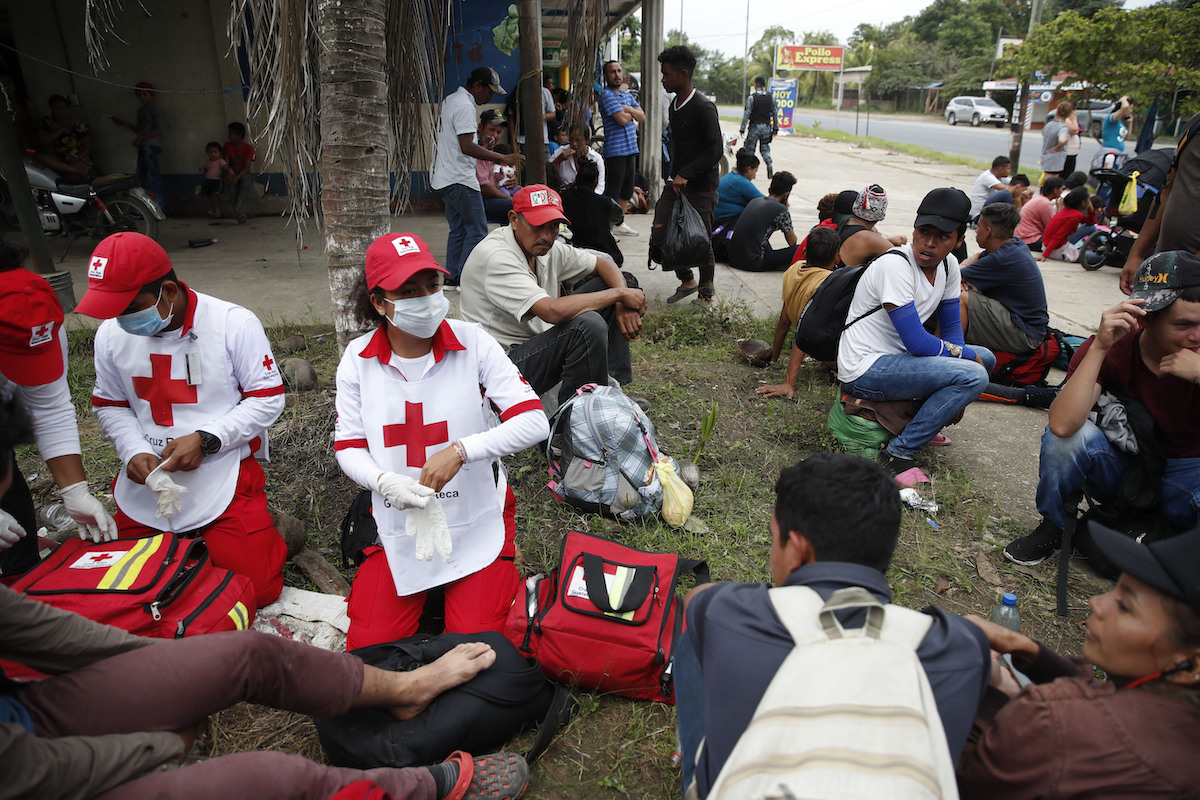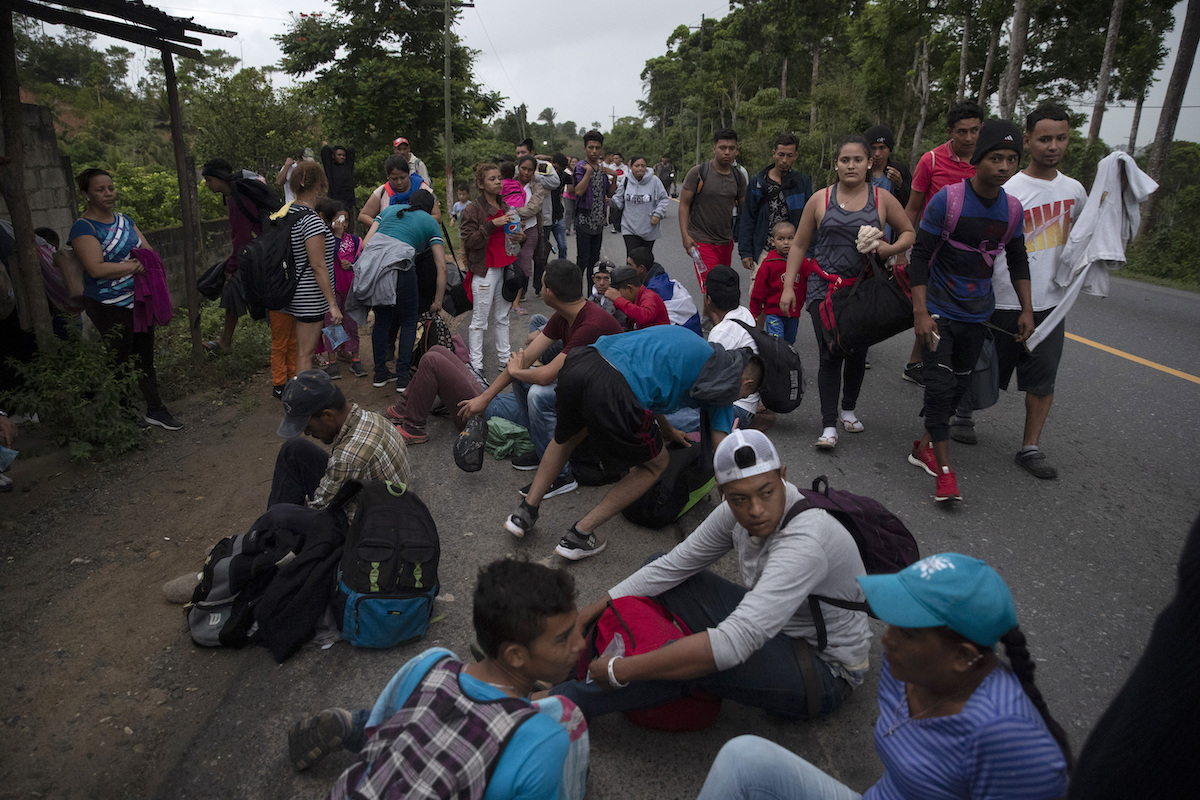

Migrants walk along a highway near Agua Caliente, Guatemala, Thursday, January 16, 2020, on the border with Honduras. (AP Photo/Santiago Billy)
By SONIA PÉREZ D., Associated Press
EL CINCHADO, Guatemala (AP) — Guatemalan police accompanied by U.S. Immigration and Customs Enforcement agents swept up the majority of a group of some 300 migrants Thursday, loaded them on buses and took them back to the Honduran border, effectively dashing their plans to travel together in a “caravan” with hopes of reaching the United States.
Near another border point, a different group of about 600 rested at a shelter after crossing the frontier earlier in the day and encountering no resistance from police. Other, smaller groups were traveling highways elsewhere in unorganized dribs and drabs in a movement involving several thousand people but far different in nature from previous caravans.
Praying and singing songs, the group of 300 migrants —adults, teens and young children— had set out from a shelter in Entre Ríos under rainy skies before dawn and walked about six hours before stopping in the town of Morales to eat and rest. There they were challenged by police who asked for their entry documents, and nearly all had crossed into Guatemala irregularly and didn’t have such documentation.
The migrants were put on three gray buses and told they had to go back to register properly at a border station under rules governing freedom of travel in the Central American border agreement between Guatemala, Honduras, El Salvador and Nicaragua.
There was no violence in the encounter, though some wept and begged to be allowed to continue, while police gave them no choice but to go back. Red Cross workers gave several migrants anti-inflammatory medicine for wounds on their feet.


Guatemalan Red Cross paramedics attends Honduran migrants before they are deported, in Morales, Guatemala, Thursday, January 16, 2020. (AP Photo/Moisés Castillo)
Guatemalan police who declined to be identified by name said the United States paid for the buses. The U.S. Embassy in Guatemala did not immediately confirm that.
The action effectively dissolved what had been the largest and most cohesive group that left the Honduran city of San Pedro Sula on Wednesday in response to a call for the first migrant caravan in many months. Guatemala’s tactics mirrored those employed last year by Mexico to discourage and break up caravans on its territory following intense pressure from Washington.
Guatemalan President Alejandro Giammattei said Wednesday that the migrants would be allowed to pass through Guatemala, though he noted they would need the proper papers and predicted they would run into a “wall” in Mexico.
Almost immediately on Wednesday most of the migrants fractured into smaller groups, some as small as 20-30 people, and began walking along highways, boarding buses and hitching rides in private cars. It was nothing resembling the mass human flows that formed in recent years, inspiring the ire of U.S. President Donald Trump and becoming a political football in the United States.
“I will say that this caravan is not anything even remotely similar to what we saw in ’18 and a little bit in ’19. A few folks here and a few folks there,” acting U.S. Homeland Security Secretary Chad Wolf said in an interview on the “Brian Kilmeade Show” on FOX News Radio. “What has changed… are the number of agreements that we have in place with Honduras, Guatemala, as well as Mexico.”
Wolf also noted the presence of U.S. “tactical agents” in Guatemala.
Guatemala’s immigration agency reported a total of 2,274 migrants registered at its El Cinchado and Agua Caliente crossings. An unknown number of others crossed irregularly.


Honduras migrants take a rest during their journey in hopes of reaching the distant United States, in Entre Rios, Guatemala, Thursday, January 16, 2020. (AP Photo/Moisés Castillo)
Many of those swept up Thursday were expected to give up and return to Honduras, even as scattered groups continued to walk and hitchhike through a tropical region of southeastern Guatemala.
Among them was Génesis Fuentes, a 19-year-old Honduran who was part of the first caravan in October 2018. Back then she made it to the northern Mexico city of Mexicali, across from Calexico, California, and lived there working as a waitress and cook for about five months. She ultimately crossed the border with some friends near Algodones, which borders California and Yuma, Arizona, but was detained by U.S. border agents and deported last May.
Clad in a red T-shirt, a hooded sweatshirt, jeans and sandals, Fuentes was limping from a bruised knee. She explained that being sent back home meant returning to a life that is no life at all.
“There is no work in Honduras,” Fuentes said. “Since they deported us, we have not been able to find jobs.”
About 100 miles (160 kilometers) to the southwest, in Esquipulas, Guatemala, the more than 600 migrants who crossed Thursday at Agua Caliente lay on the ground under a low, gray sky, sleeping or eating. A plan was forming to spend the night there and leave before dawn Friday.
Jomas Joel Paredes of Villanueva, Honduras, left San Pedro Sula on Thursday morning, a day after most of the other migrants. He had luck hitching rides, and the truck he was aboard was not stopped before the border.
He said it was his fourth attempt at migrating to the United States. He never got any farther than Mexico in any of the other tries, the most recent in 2017.
Paredes said he was fleeing gang threats, debts and unemployment. He had heard in the local press that Mexico said it wouldn’t let migrants pass, but he hoped the government would change its tune. He has plans to work in Mexico for a while and send money back home before eventually trying to reach the United States.
He left his wife and three daughters behind in Honduras.
“Those are decisions one has to make sometimes,” Paredes said.
Less-organized migrants, tighter controls by Guatemalan and Mexican authorities and the presence of U.S. advisers have reduced the likelihood of a repeat of the huge, cohesive processions that the term “caravan” came to conjure in 2018.
Guatemala is stricter about checking documents, and Mexico has deployed thousands of National Guard agents in key corridors to do immigration control. Asylum seekers who manage to make it to the U.S. border are, after long waits, generally sent back to Mexico to await the outcome of their cases or, more recently, flown to other countries in the region and told their only option is to apply for refuge there.
***
Associated Press photojournalist Santiago Billy in Esquipulas, Guatemala, and AP writer Christopher Sherman in Mexico City contributed to this report.



its assuring for US citizens to see that people are getting that the world is not our responsibilty
[…] have been deployed to Guatemala to block migrants from Honduras, according to a January 16 report from the Associated […]
[…] have been deployed to Guatemala to block migrants from Honduras, according to a January 16 report from the Associated […]
[…] have been deployed to Guatemala to block migrants from Honduras, according to a January 16 report from the Associated […]